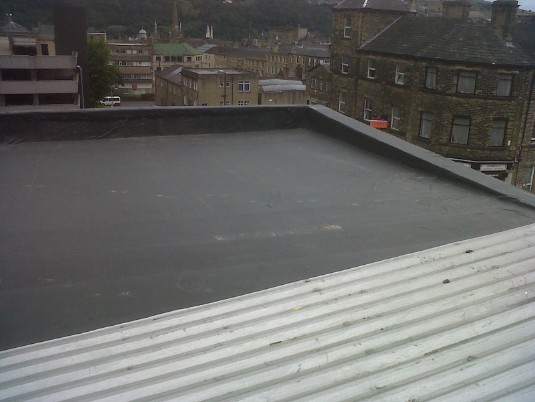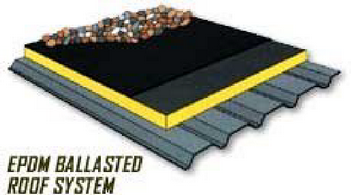
A rubber roof, known in the roofing business as an EPDM (ethylene propylene diene terpolymer) roof, has a lot of advantages and only a few disadvantages. One of the big advantages to rubber is the cost.
Although a homeowner must use a licensed installer to lay down this
roof, the cost of the entire job still favorably compares to the cost
for other types of roofing. Not only is the roofing material itself less
expensive than most other choices, but the product is also lightweight,
and installation is fast and easy, reducing labor and installation
costs. The rubber is glued into place, negating the use of heat, which
can adversely affect a homeowner’s insurance policy.
CONS
One of the primary drawbacks to a rubber roof is its appearance. Most EPDM roofs are black. However, many manufacturers now make a white or off-white for residential use, and it is very easy and inexpensive for a homeowner to have an EPDM roof painted almost any color with an acrylic paint. The use of an acrylic paint is actually recommended as it prolongs the life of the roof even longer.
Some manufacturers are also producing EPDM roofing in long thin strips, which can be cut to resemble shingles. These faux shingles must still be installed by a professional, but they can go a long way to making an EPDM roof look almost identical to most other roofs in a neighborhood. And, of course, rubber shingles can be painted almost any color to resemble other types of roofs while still providing the homeowner with 50 years or more of unsurpassed protection.
Finding the right roofer can also be a problem. Many roofers pretend to be proficient in installing EPDM when, in fact, they are not. Using the wrong roofer to install a rubber roof can lead to problems down the line due to incorrect installation and can even negate a warranty on the rubber itself.
Virtually the only negative for a rubber roof is appearance, and even that drawback can be overcome with the use of rubber shingles or acrylic paint. With each passing week, new tweaks are being made in the fast-changing world of rubber roofing, so it behooves a homeowner to speak with the roofing experts at United Home Experts for the very latest information on rubber roofs.

PROS
Rubber is also long-lasting. Most of these roofs are laid in a single piece, which means there are no seams or very few, depending on the exact layout of the roof. Few seams mean few places for water to seep under the roofing and destroy the home. And because modern rubber is not susceptible to the sun’s UV and ultraviolet rays, a properly-installed rubber roof can last 50 years or even longer. Rubber can withstand high winds and even hail up to three inches in diameter. Many rubber roofs laid down in the 1970s are still in use today.
Another large advantage of rubber is that if the roof ever does have a leak, repairs are fast, easy and extremely inexpensive. In many cases a tube of liquid rubber is all that is needed; in other cases, a special tape designed specifically for repairing rubber will do the job. In any event, repairing one of these roofs, if and when it should become necessary, is almost never a problem.
Maintenance is another advantage. Almost all roofing materials require some maintenance over the years, but rubber requires little if any care. The most that a homeowner may wish to do is to repaint the roof with acrylic paint once every 10 to 12 years.
Rubber roofs come in a variety of thicknesses, from 45mm all the way up to 90mm. Which size is right for any particular home depends on the location of the home, the pitch of the roof and several other factors. Homeowners are encouraged to talk to the knowledgeable roofing experts at United Home Experts to learn which thickness is right for their home and to ask any other roofing questions. The experts at United Home Experts sell and install a wide range of roofing products, so their honest answers are never based on commissions.
Rubber is also one of the “greenest” choices that a homeowner can make. The rubber itself takes less energy to produce than most other roofing materials and is often made from recycled materials, to begin with. And the roof is 100% recyclable at the end of its long life.
Rubber is fire resistant. Not only is such a roof almost impossible to set afire, even with a lightning strike, but the rubber is actively resistant to all forms of fire and can slow a fire to the point that help has time to arrive. Homeowners should check with their homeowner’s insurance to see if there is a rate reduction for installing an EPDM roof.
EPDM roofs are also extremely energy efficient. An EPDM roof reflects the sun’s heat, especially the lighter-colored roofs designed for residential use, saving the homeowner considerably on air conditioning costs. EDPM also insulates the home, trapping in heat to reduce energy costs and utility bills in the colder months. The homeowner does not have to worry about the rubber freezing or cracking under extremes of cold weather. Modern EPDM roofing is designed to take both extremes of cold as well as heat.
